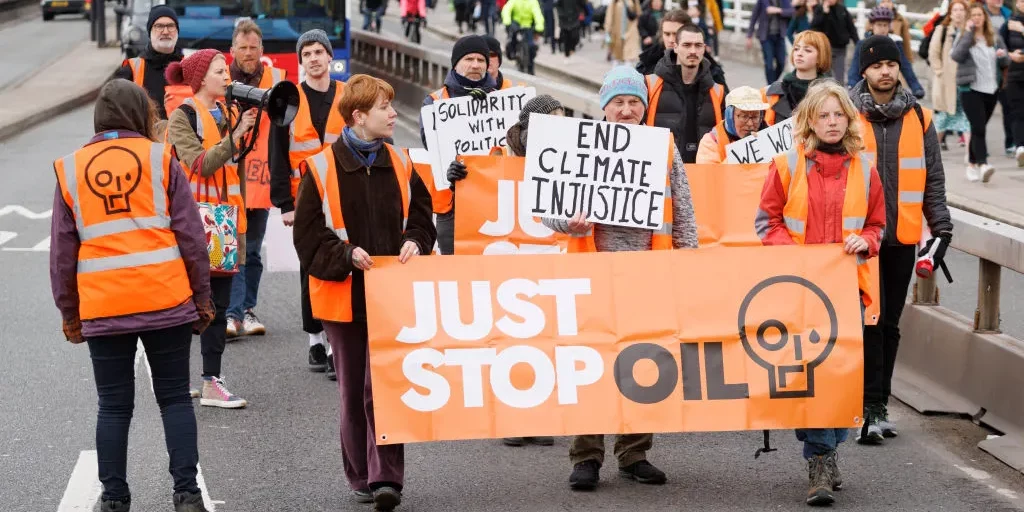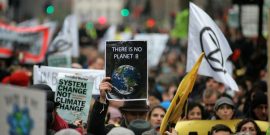Activists' obsession with government policies and international agreements distracts from a market-driven trend toward lower emissions.
Climate Activism’s True Believers
Today’s radical climate activists are a confusing breed. They are convinced that we are facing the greatest challenge mankind has ever had to meet: the climate catastrophe. This catastrophe, they proclaim, is imminent and will have calamitous repercussions. Bundled together in the supra-national advocacy group A22 Network, which is funded by the American Climate Emergency Fund, these extreme climate activists are predominantly young people, who are passionate and have a moralistic zeal and steadfast convictions. They engage in civil disobedience such as blocking roads, they are willing to give up their lives for their cause, and they proclaim to follow the science. They are convinced that the time frame for action is rapidly decreasing. So, they urge us to just listen to the science and go for “a mad dash to try and save humanity”!
But although they have these strong convictions about the impending doom of climate change, they pay little attention to finding and pursuing the best way to combat it. This lack of consideration is evident in their disregard for the findings of economics that primarily recommend price-based measures such as the CO2 emission trading scheme to address climate change. Listen to the science, but only to some branches of it?
Moreover, radical climate activists often remain silent on the use of nuclear energy, one of the world’s safest and climate-friendliest technologies. In Germany, where the government completely stopped nuclear energy, resulting in a distressingly poor emissions track record, the radical climate activists are fighting for cheap public transport, speed limits on motorways, and more direct democracy. However, they keep quiet on a price-based system or nuclear energy as a solution, often subscribing to the irrational fearmongering about nuclear energy that is associated with the Chernobyl disaster. In short, the same radical climate activists who urge us to act quickly to “save humanity” from the greatest catastrophe imaginable seem unconcerned about the best way to tackle this supposedly daunting task.
This is a profound conundrum: those we should expect to be most concerned with discovering how best to tackle this millennial challenge are little, if at all, interested in this, nor in the adoption of adequate means to tackle climate change. To solve this conundrum, one must understand the climate activists, or rather, the crisis of meaning in the twenty-first century. For this, the A22 Network’s declaration is revealing, as it unveils the messianic, religious calling the activists expressly perceive to follow, which is a key feature of this group. They write:
We are the Last Generation of the old world. We are here today to say we will create a new world—where humanity embraces itself, forgives itself, loves itself and commits to continue our great adventure. … Together, in community, we are taking hold of a higher purpose. The source of what it is to be truly human. It calls to us across the ages.
These young activists believe that a much better world is within reach. A world where justice prevails and where humanity evolves into a higher being. And creating this new world is the calling they are following. This means that combating climate change, for these people, is about more than just combating climate change. Or, rather, it is not, at least primarily, about combating climate change, but about being good: it is a moral pursuit. And thus it becomes understandable why the British Just Stop Oil, part of the A22 Network, tells us that “If you are not in resistance you are appeasing evil.”
As climate activism is a holy, religious cause they follow, the activists are mainly looking for virtuous adherence to their professed ideals and the creation of a new, better world.
Seen from this perspective, what the climate activists long for is not primarily a world that tackles climate change, but a world that is just and conforms to their idealistic visions of a perfect society. Of course, such a world would also stop climate change and mitigate its repercussions. But, as the declaration tells us, chiefly it is a world “where everyone will be free,” where “justice [will] be done,” and where “love and truth” reign.
Since the main cause that climate activists follow is moralistic, rather than pragmatic, it makes sense that there is a confusing lack of concern for the suitability of means and that some means, such as emission trading, are deemed unsuitable. While price-based measures would presumably go a long way to solve the “climate crisis,” they would, in the eyes of many activists, uphold the current unjust and ugly capitalist system, and thus fail to create the new, superior, better world that the activists are striving for. That this world is one that is no longer capitalist but rather conforms to socialist ideals is presumably simply a manifestation of the anti-capitalist zeitgeist predominant amongst the young and the intellectuals.
However, the climate activists’ verve—and the fact that these groups emerged as new grassroots movements—suggests that they are more than covert supporters of socialist ideals or welcome marketers used by the anti-capitalists, although such a connection may not be ruled out. But even if this is not entirely clear and the origins of the climate activists’ lofty anti-market ideals may remain disputed, what is obvious is that these ideals demand solving climate change in a virtuous way. Therefore, to the activists, some means are unacceptable, irrespective of their general suitability.
There is another element that makes climate activism attractive. Not only is there an ideal, perfect world to be won in this fight: giving up one’s life for a “higher purpose,” as the term appears in the declaration, also gives meaning to the activist. Now she has something worth fighting for: a just moral cause that she can follow and a task in which she can be completely absorbed in. She, and all the other activists, now have the great opportunity to live for something that is greater than themselves. In short, what climate activism gives to those immersed in it is the chance to find meaning in a profoundly moral endeavor. This is just what Eric B. Hoffer said about mass movements and their true believers in his famous book The True Believer:
Their innermost craving is for a new life—a rebirth—or, failing this, a chance to acquire new elements of pride, confidence, hope, a sense of purpose and worth by an identification with a holy cause. An active mass movement offers them opportunities for both.
If my diagnosis that climate activists are true believers in a mass movement is correct, it suggests that the issue is a lack of meaning that especially young people in today’s Western democracies experience. They struggle to find meaning in their everyday lives, which may have a lot to do with the decline of the role of religion but also the family in society. Not able to find meaning, they become frustrated, which Hoffer stresses as the main feature of those who become true believers, and thereby vulnerable to anything that offers them purpose and meaning. Climate activism, as a mass movement, can satisfy this demand, gifting adherents a holy cause to follow and identify with. In principle, other ideologies might also provide meaning to the frustrated—this is why Hoffer emphasizes that mass movements, for the true believers, are interchangeable.
However, as the mass movement is an escape from personal responsibility, not any task will do. The emphasis on the need for global, and governmental, action that the climate activists voice is instructive. With this it is clear that great leaders will have to take action and tackle the climate challenge, allowing the movement’s believers to evade practical responsibilities. Moreover, the reason why climate activism became so prominent may simply resonate with the fact that, after all, climate change is a big challenge for humans and one that has received lots of attention for quite a long time.
Understanding today’s extreme climate activism as the outgrowth of frustrated people who find meaning by seizing climate activism as a holy cause can solve the conundrum I posited above. It explains why actually tackling climate change, paradoxically, is not of primary importance to the activists, and thus why they care little for the efficiency and efficacy of their means. As it is a holy, religious cause they follow, the activists are mainly looking for virtuous adherence to their professed ideals and the creation of a new, better world. This also explains their passion and the self-denying character that much of the protest has—the most extreme activists actually went on a hunger strike, while others willingly risked going to prison. People are giving up their lives because they are now part of a greater movement, fighting for a cause that is bigger than themselves.
While this Hoffer-inspired explanation can solve this conundrum of the climate activists, I believe it also points to the solution. In order to solve both climate change and reduce the attractiveness of mass movements, people need to find ways to discover meaning in their lives on their own. Then, they will no longer need mass movements to find happiness and purpose. Consequently, a sober, critical analysis of the means suitable to tackle climate change becomes possible, which could manifest in a balanced treatment of the issue in schools and universities but also in the media more generally. Then, the adequate means to combat climate change can be adopted—and the “climate crisis,” if it truly exists—will be solved.



